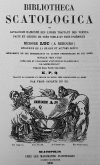Coprophagy in nineteenth-century psychiatry
- PMID: 30425610
- PMCID: PMC6225515
- DOI: 10.1080/16512235.2018.1535737
Coprophagy in nineteenth-century psychiatry
Abstract
This paper shows how Austrian psychiatrists of the 1870s developed the first pathological accounts of institutional coprophagia, examining how they related the behaviour to mental illness and dementia. These ideas about coprophagia contrasted dramatically to the long European pharmacological tradition of using excrement for the treatment of a wide range of health conditions. Recent medical scholarship on institutional coprophagia is also reviewed here, with a novel hypothesis proposed about why some patients in long-term care resort to the behaviour in institutions where there is little opportunity for healthy human-microbe interactions.
Keywords: Coprophilia; history of coprophilia; history of excrement as medicine; history of scatological behaviour.
Figures





References
-
- Paullini CF.Heilsame Dreck-Apotheke wie nämlich mit Koth un Urin fast alle, ja auch die schwerste griffstigste Krankenheit un bezauberte Schäden von Haupt bis zum Füssen, in un äusserlich glücklich curirt worden. Frankfurt am Main: Knochen; 1696.
-
- Van Helmont JB. Oriatrike, or Physick Refined. London: Lodowick Loyd; 1662. p. 211–12.
-
- Stapelberg -M-M. Through the darkness: glimpses into the history of western medicine. London: Crux Publishing; 2016. p. 78.
-
- Erlenmeyer A. Die luëtischen Psychosen, in diagnostischer, prognostischer un therapeutischer Bezeihung. Neuwied: J.H. Heuser; 1877.
-
- Mayer A. Sites of the unconscious: hypnosis and the emergence of the psychoanalytic setting. Chicago: University of Chicago Press; 2013. p. 122.
LinkOut - more resources
Full Text Sources
